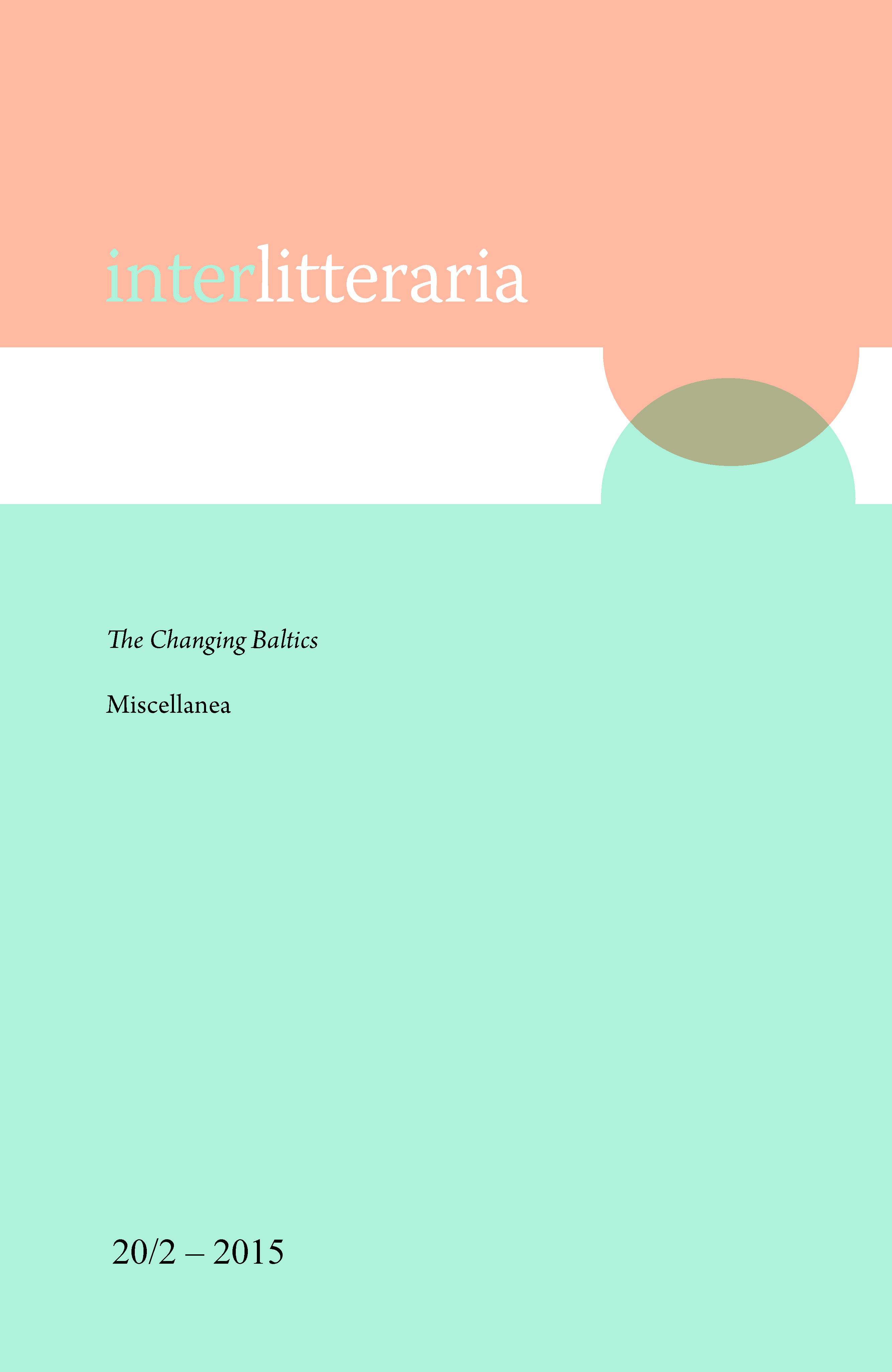The New Women from the Margins
DOI:
https://doi.org/10.12697/IL.2015.20.2.15Keywords:
New Woman, fin de siècle, Slovenian literature, Finnish literature, Zofka Kveder, L. OnervaAbstract
The New Woman makes an appearance in the texts of both male and female fin de siècle writers, although unsurprisingly she was more often an important focus for women writers. And although women writers from the margins of Europe faced many challenges that were similar to those of their contemporaries in English speaking countries, they were also simultaneously confronted with local and contextually specific issues. In this article, we tackle the specificities of the literary New Women in Slovenian and Finnish literature, and in particular, the texts of Zofka Kveder (1878–1926) and L. Onerva (1882–1972). Both women writers sought ways of engaging with questions of female identity in societies obsessed with cultural nationalism, and which saw woman primarily in terms of her role as wife and mother. Both L. Onerva and Kveder foregrounded the New Woman, depicting her as wanting to live her life on her own terms, even if this coincided with a painful awareness of the difficulty of such an enterprise. Both writers suggested that the New Woman’s personal ambivalences and inhibitions were often felt more acutely than any external force. L. Onerva and Kveder enriched Finnish and Slovenian literature with bold new themes and depictions, adding their own provocative ideas about love, sexuality, and emancipation to those being expressed by other better known New Woman writers, including Ellen Key.Downloads
Download data is not yet available.
References
<div class="WordSection1"><p>Bernheimer, C. 1989. <em>Figures</em><em> </em><em>of Ill Repute: Representing Prostitution in Nineteenth-Century France. </em>Cambridge, Massachussetts & London, England: Harvard University Press.</p><p>Cohen M. / Dever, C. 2002. <em>The Literary Channel: The Inter-National Invention of the Novel</em>. Princeton: Princeton University Press.</p><p>Dijkstra, B. 1986. <em>Idols of Perversity. Fantasies of Feminine Evil in Fin de Siècle Culture. </em>New York and Oxford: Oxford University Press.</p><p>Dowling, L. 1979. The Decadent and the New Woman in the 1890s. – <em>Nineteenth-Century Fiction</em>, 33, 4, 434–453. <a href="http://dx.doi.org/10.2307/2933251" target="_blank">http://dx.doi.org/10.2307/2933251</a></p><p>Felski, R.1995. <em>The</em><em> </em><em>Gender</em><em> </em><em>of Modernity</em>. Cambridge (Mass.) & London: Harvard University Press.</p><p>Fuss, D. 1995. <em>Identification Papers. </em>London & New York: Routledge.</p><p>Higgonet, M. 1986. Speaking Silences: Women’s Suicide. – S. Rubin Suleiman, ed., <em>The Female Body in Western Culture. Contemporary Perspectives</em>. Cambridge, Massachusetts & London, England: Harvard University Press, 68–83.</p><p>Hyttinen, E., Melkas, K. 2009. ‘Me olemme teidän luomianne olentoja.’ Prostituoidun hahmo kirjallisena kiistakuvana vuonna 1907. – K. Launis, M. Tikka, eds., <em>Tyoväki ja kokemus. </em>Helsinki: Työväen historian ja perinteen tutkimuksen seura, 122–137.</p><p>Jensterle-Doležal, A. 2008. Podobe identitete in travma telesa v prozi Zofke Kveder. – J. Jahič Honzak, A. Jensterle, eds., <em>Zofka </em><em>Kveder</em><em> </em><em>(1878-1926).</em><em> </em><em>Recepce</em><em> </em><em>její</em><em> </em><em>tvorby</em><em> </em><em>v </em><em>20.</em><em> století</em>. Praha: Slovanská knihovna, Národní knihovna. Kveder, Z. 2005. <em>Zbrano delo 1</em>. Ljubljana: Litera.</p><p>Kveder, Z. 2010. <em>Zbrano delo 2. </em>Ljubljana: Založba ZRC.</p><p>L. Onerva. 1905. <em>Musset’n naisluonteet. </em>Laudaturtyö. KIA/Literary Archive of the Finnish Literature Society.</p><p>L. Onerva. 1908/1956. <em>Mirdja. </em>3rd ed. – <em>Valitut</em><em> teokset, </em>Helsinki: Otava.</p><p>L. Onerva. 1909a. Eräitä kehitysviivoja. – <em>Helsingin Sanomat </em>06.01.</p><p>L. Onerva. 1909b. <em>Murtoviivoja</em>. Helsinki: Otava.</p><p>L. Onerva. 1911. <em>Nousukkaita. </em>Helsinki: Yrjö Weilin & kumpp.</p><p>L. Onerva. 1912. <em>Mies ja nainen</em>. Helsinki: Kirja.</p><p>L. Onerva. 1913. <em>Inari. </em>Helsinki: Weilin & Göös.</p><p>L. Onerva. 1915. <em>Vangittuja sieluja</em>. Helsinki: Kirja.</p></div><p>Launis, K. 2005. <em>Kerrotut</em><em> </em><em>naiset.</em><em> </em><em>Suomen</em><em> </em><em>ensimmäiset</em><em> </em><em>naisten</em><em> </em><em>kirjoittamat</em><em> </em><em>romaanit</em><em> </em><em>naiseuden</em><em> määrittälijöinä. </em>Helsinki: Suomalaisen Kirjallisuuden Seura.</p><p>Ledger, S. 1997. <em>The</em><em> </em><em>New</em><em> </em><em>Woman: Fiction and Feminism at the Fin de Siècle</em>. Manchester; New York: Manchester University Press.</p><p>Leerssen, J. 2006. <em>National</em><em> </em><em>Thought</em><em> </em><em>in</em><em> </em><em>Europe:</em><em> </em><em>A Cultural History</em>. Amsterdam: Amsterdam University Press.</p><p>MacKay, C. H. 1994. Lines of Confluence in Fredrika Bremer and Charlotte Brontë. – <em>NORA, </em>2, 119–129. <a href="http://dx.doi.org/10.1080/08038740.1994.9959664" target="_blank">http://dx.doi.org/10.1080/08038740.1994.9959664</a></p><p>Mihurko Poniž, K. 2003. <em>Drzno</em><em> </em><em>drugačna.</em><em> </em><em>Zofka</em><em> </em><em>Kveder</em><em> </em><em>in</em><em> </em><em>podobe ženskosti. </em>Ljubljana: Delta.</p><p>Mitchell, S. 1999. New Women, Old and New. – <em>Victorian Literature and Culture </em>27, 2, 579–588. <a href="http://dx.doi.org/10.1017/S1060150399272221" target="_blank">http://dx.doi.org/10.1017/S1060150399272221</a></p><p>Moretti, F. 1998. <em>Atlas of the European Novel, 1800-1900</em>. London, New York: Verso.</p><p>Parente-Čapková, V. 2003. Free Love, Mystical Union or Prostitution? The Dissonant Love Stories of L. Onerva.– P. Lyytikäinen ed., <em>Changing Scenes. Encounters between European and Finnish Fin de Siècle. </em>Studia Fennica Litteraria,1. Helsinki: Finnish Literature Society, 54–84.</p><p>Parente-Čapková, V. 2014. <em>Decadent</em><em> </em><em>New</em><em> </em><em>Woman</em><em> </em><em>(Un)Bound:</em><em> </em><em>Mimetic</em><em> </em><em>Strategies</em><em> </em><em>in</em><em> </em><em>L.</em><em> </em><em>Onerva’s Mirdja</em>. Turku: Annales Universitatis Turkuensis, Humaniora, Ser. B, Vol. 378.</p><p>Rajainen, M. 1973. <em>Naisliike ja sukupuolimoraali. keskustelua ja toimintaa 1800-luvulla ja nykyisen vuosisadan alkupuolella noin vuoteen 1918 saakka. </em>Suomen Kirkkohistoriallisen Seuran toimituksia 91. Helsinki: Suomen Kirkkohistoriallinen Seura.</p><p>Showalter, E. 1993. <em>Daughters of Decadence: Women Writers of the Fin-de-Siècle</em>. New Brunswick (N. J.): Rutgers University Press.</p><p>Tuohela, K. 2008. <em>Huhtikuun</em><em> </em><em>tekstit.</em><em> </em><em>Kolmen</em><em> </em><em>naisen</em><em> </em><em>koettu</em><em> </em><em>ja kirjoitettu melankolia 1870–1900. </em>Helsinki: Suomen Kirjallisuuden Seura.</p><p>Willis, C. 2001: “Heaven Defend Me from Political or Highly Educated Women!”: Packaging the New Woman for Mass Consumption. A. Richardson, C. Willis, eds., <em>The New Woman in Fiction and in Fact: Fin-de-Siècle Feminisms. </em>Basingstoke; New York: Palgrave Macmillan, 53–65.</p>Witt-Brattström, E. ed., 2004. <em>The New Woman and the Aesthetic Opening: Unlocking Gender in Twentieth-Century Texts. </em>Södertörn Academic Studies 20. Stockholm: Södertörn högskola.
Downloads
Published
2015-12-31
Issue
Section
Articles
License
The contents of Interlitteraria are published under CC BY-NC-ND licence.


